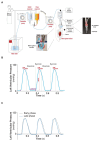A Closed Circulation Langendorff Heart Perfusion Method for Cardiac Drug Screening
- PMID: 39903886
- PMCID: PMC11835219
- DOI: 10.33549/physiolres.935324
A Closed Circulation Langendorff Heart Perfusion Method for Cardiac Drug Screening
Abstract
Cardiovascular diseases represent an economic burden for health systems accounting for substantial morbidity and mortality worldwide. Despite timely and costly efforts in drug development, the cardiovascular safety and efficacy of the drugs are not always fully achieved. These lead to the drugs' withdrawal with adverse cardiac effects from the market or in the late stages of drug development. There is a growing need for a cost-effective drug screening assay to rapidly detect potential acute drug cardiotoxicity. The Langendorff isolated heart perfusion technique, which provides cardiac hemodynamic parameters (e.g., contractile function and heart rate), has become a powerful approach in the early drug discovery phase to overcome drawbacks in the drug candidate's identification. However, traditional ex vivo retrograde heart perfusion methods consume a large volume of perfusate, which increases the cost and limits compound screening. An elegant and cost-effective alternative mode for ex vivo retrograde heart perfusion is the constant-flow with a recirculating circuit (CFCC), which allows assessment of cardiac function using a reduced perfusion volume while limiting adverse effects on the heart. Here, we provide evidence for cardiac parameters stability over time in this mode. Next, we demonstrate that our recycled ex vivo perfusion system and the traditional open one yield similar outputs on cardiac function under basal conditions and upon ?-adrenergic stimulation with isoproterenol. Subsequently, we validate the proof of concept of therapeutic agent screening using this efficient method. ?-blocker (i.e., propranolol) infusion in closed circulation countered the positive effects induced by isoproterenol stimulation on cardiac function. Keywords: Drug development, Drug screening, Cardiovascular safety, Langendorff method, Closed circulation.
Conflict of interest statement
Figures



Similar articles
-
Large-Animal Biventricular Working Heart Perfusion System with Low Priming Volume-Comparison between in vivo and ex vivo Cardiac Function.Thorac Cardiovasc Surg. 2018 Jan;66(1):71-82. doi: 10.1055/s-0036-1580604. Epub 2016 Apr 4. Thorac Cardiovasc Surg. 2018. PMID: 27043784
-
Integration of cardiac energetics, function and histology from isolated rat hearts perfused with doxorubicin and doxorubicin-ol; a model for use in drug safety evaluations.J Pharmacol Toxicol Methods. 2018 Nov-Dec;94(Pt 2):54-63. doi: 10.1016/j.vascn.2018.08.004. Epub 2018 Sep 6. J Pharmacol Toxicol Methods. 2018. PMID: 30195582
-
The isolated, perfused working heart preparation of the mouse-Advantages and pitfalls.Acta Physiol (Oxf). 2025 Apr;241(4):e70023. doi: 10.1111/apha.70023. Acta Physiol (Oxf). 2025. PMID: 40078031 Free PMC article. Review.
-
Triiodothyronine increases contractility independent of beta-adrenergic receptors or stimulation of cyclic-3',5'-adenosine monophosphate.Anesthesiology. 1995 Apr;82(4):1004-12. doi: 10.1097/00000542-199504000-00025. Anesthesiology. 1995. PMID: 7717535
-
Retrograde heart perfusion: the Langendorff technique of isolated heart perfusion.J Mol Cell Cardiol. 2011 Jun;50(6):940-50. doi: 10.1016/j.yjmcc.2011.02.018. Epub 2011 Mar 6. J Mol Cell Cardiol. 2011. PMID: 21385587 Review.
